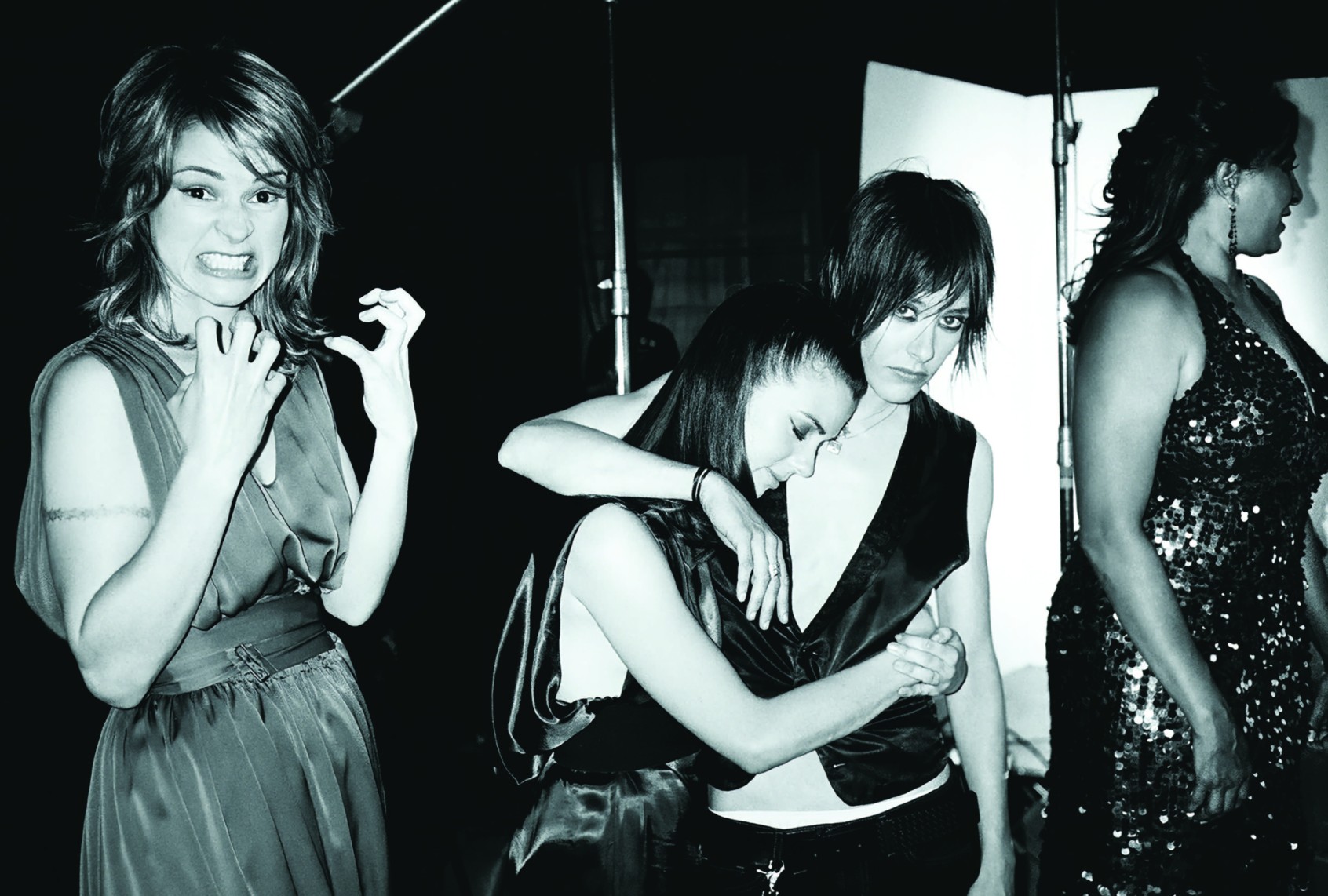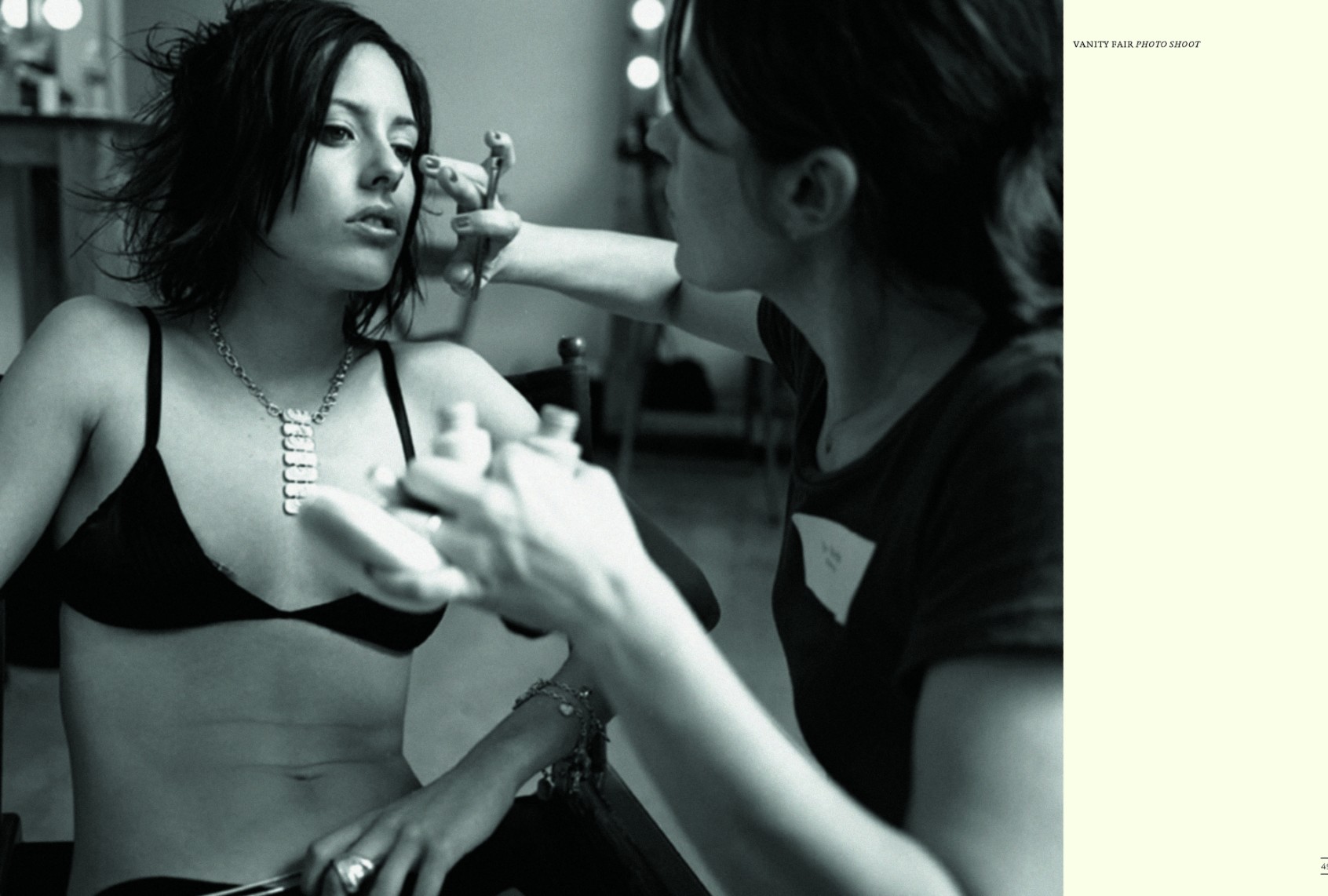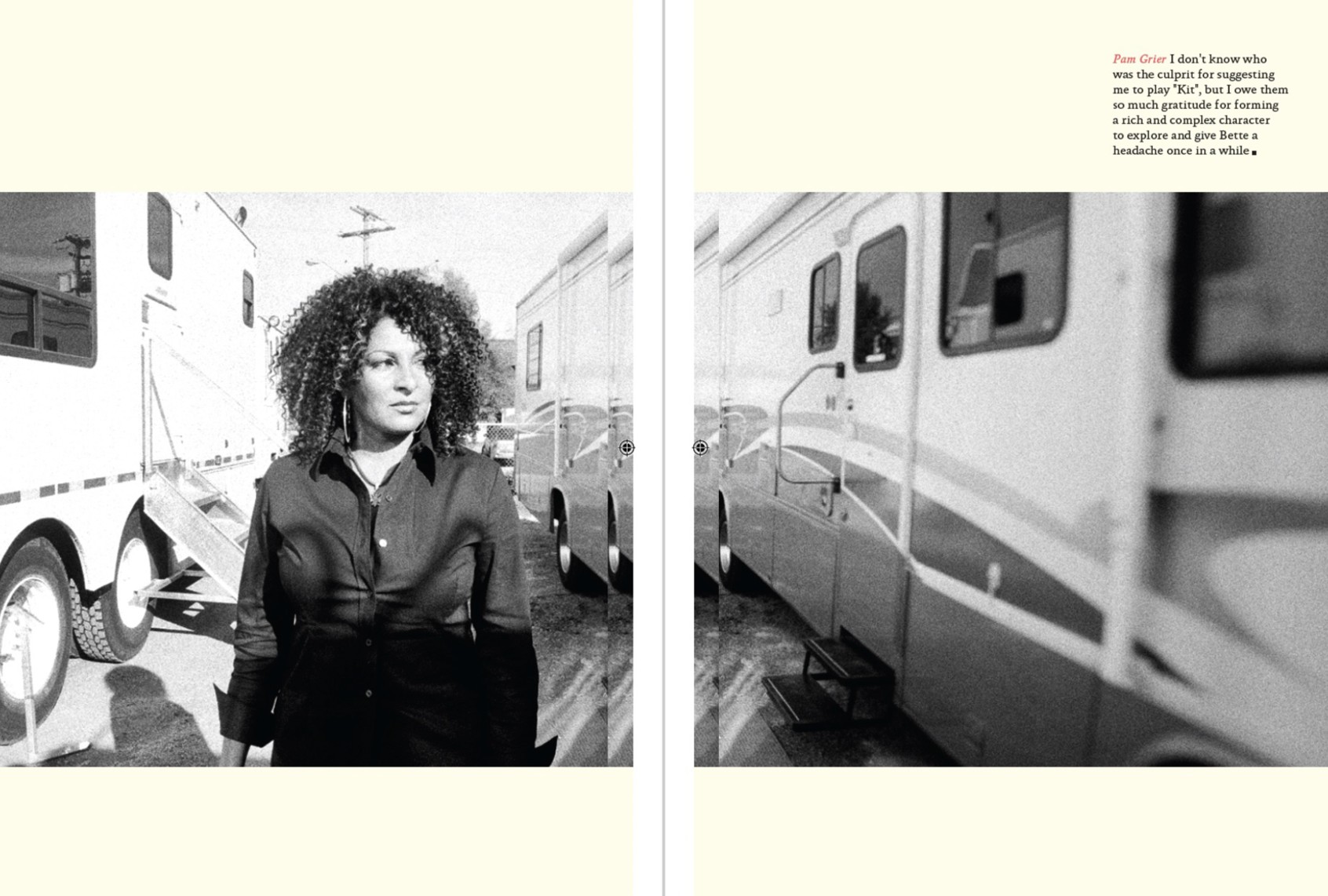I knew that Jennifer Beals and I were going to have a fantastic conversation when, after connecting on Zoom and chatting for a bit, she asked if I would mind it if she turned off her camera because it helps her concentrate better. Opening up about being what she describes as “very shy,” she went on to describe her inspiration for pursuing a wide release of “The L Word: A Photographic Journal,” a collection of photos she’d personally taken during the filming of the original “L Word” series, which she’d compiled into a book in 2010 to hand out to the cast and crew after they’d wrapped the show. Having bowed out of fan events due to a certain level of uncomfortability being in crowds of strangers, she was convinced by cast members Leisha Hailey and Kate Moennig to join them at an event taking place in the U.K. one year, and it was there that she learned that fans weren’t just interested in the photos she’d taken, they all but demanded greater access to them.
Opting for a physical book over something like a gallery show or simply sharing the photos online because, she says, "it’s nice sometimes to just have something to touch," she looks back at the act of taking them as not only a way to steady herself and calm her nerves on set, but to capture and preserve the "lightning in a bottle" show, as she describes it — and as fans see it — that is "The L Word," a show that ended it's original run 16 years ago and has still — even factoring in its three season continuation, "The L Word: Generation Q" — not been replaced in the hearts of fans, in terms of popularity and the offering of a weekly meeting place, on television, for the full spectrum of the LGBTQ+ community to see their lives reflected back at them with a whole cast of characters, and not just one or two.
"I’m just hoping where there’s a will, there’s a way. And who knows how long it’ll take. I could be rolling up in my wheelchair," Beals said when asked about rumors of a new "L Word" series, possibly based in New York.
Read our full conversation below to learn more about “The L Word: A Photographic Journal,” Beals' new media venture with "L Word" creator Ilene Chaiken and former longtime Condé Nast chief revenue officer Pamela Drucker Mann called Run-A-Muck, and what her "L Word" character, Bette, would have to say about all the arts de-funding taking place.
The following interview has been edited for length and clarity.
I feel like I’ve been hearing about this book for quite some time, catching exchanges between fans of “The L Word” on social media who snagged an earlier version of it during limited release drops and bragging of their copy as though it was a rare biblical text. How does this wide release version differ from the earlier one and what made 2025 feel like a good year to release it?
The only reason it’s out here now is because of the fans. I had originally made the book as sort of a personal remembrancer and as a gift for the cast and crew after our final year of shooting. And Kate and Leisha had invited me to an "L Word" convention in the U.K. — they had gone to several and I’d never been to one, and they said, "You’re really gonna love it, everybody’s so great," so I finally went. I didn’t go [previously] because I’m really shy and it’s hard for me to be in big groups of people that I don’t know, but in any case, it became clear to me how amazing our fans are and how they really wanted to immerse themselves in this world — it wasn’t just another TV show.
"There’s been a whole new generation that’s discovered the show. And so the book is sort of like this bridge for them.
And so I thought, oh, I should make the book available to them, I think they would appreciate it. So I did these interviews with the cast and I made the book available in a limited quantity for the fans, and then people started asking to bring back the book. And I think what’s so fascinating is that over time, there’s been a whole new generation that’s discovered the show. And so the book is sort of like this bridge for them, in a way. And bringing it back in 2025, there was no great strategy; it was just fans asking for the book, me being lazy, finally then not being lazy, and finding a publisher for the book. But I think it was kind of divine intervention because I think we’re at a really important point where the book has become more than just a bit of nostalgia for a show. It’s about remembering how far queer representation has come and hopefully inspiring future storytelling. It also has made me start thinking about collective memory and how photography contributes to collective memory and how collective memory can be a firewall against erasure. And we’re now at this point in the United States where there are people trying to legislate away the existence of people within the LGBTQ+ community, literally trying to erase them from statues. And it is critically important we remember the community and celebrate the community and I’m just so glad the book is out now.
 Leisha Hailey, Mia Kirshner, Kate Moennig and Pam Grier behind-the-scenes of "The L Word" (Courtesy of Weldon Owen/Jennifer Beals)When you look at the photos in this book, what are some thoughts and emotions that surface for you?
Leisha Hailey, Mia Kirshner, Kate Moennig and Pam Grier behind-the-scenes of "The L Word" (Courtesy of Weldon Owen/Jennifer Beals)When you look at the photos in this book, what are some thoughts and emotions that surface for you?
Well, it’s interesting because I put the book together in 2010. I always save all of my scripts anyway because it serves as a library if you’re mining a character for six years — you don’t know if it’s gonna be six years, or three years, or two years, or one year — but to save all the material, that helps to inform the character, for me anyway, that’s important. So I was saving all the scripts anyway, but I was also saving all the other bits of ephemera and, of course, taking photos every day. And in terms of what photographs were included, I broke the book down by seasons, although there is a whole section on dogs. And I think that’s partially because the circus, where all the trailers are — In Canada we call it the circus. I think they call it base camp in the U.S., which is a crucial difference between the United States and Canada. To document that life at the trailers was really important because that’s where we spent quite a bit of our time getting ready and having lunch and all manner of things, preparing for scenes, so I knew that it certainly was important to include those photos. But it was more instinctual.
"I love the idea of an object also helping to facilitate community."
But I really wanted to show how we were gathering in all of these other spaces that weren’t in front of the camera. And how all of that mayhem and mischief and joy that was going on beyond the camera was informing what was in front of the camera. It’s not a photography book, it’s a photographic journal. Because if I were making a photography book, there are lots of photos I wouldn’t include. Stuff where the focus is a little soft, or that I wouldn’t necessarily consider to be a successful photograph, but it’s a wonderful remembrancer for me, and for the cast, and hopefully the audience beyond the cast will sense some kind of meaning in the photographs. And certainly, in this day and age, I could have taken photos through AI and sharpened them. But I just thought, you know, then it doesn’t feel like a yummy mistep of an analogue photo, which speaks almost to the haziness of memory, in and of itself.
And with AI, everyone would have had 13 fingers and two noses and stuff.
[Laughs] But with photography, you can put things through and it can sharpen things, but that’s not the sentiment of this book. The sentiment is that through these mistakes, through the error, through the messiness, the culmination of all of that is greater than the sum of its parts.
Want a daily wrap-up of all the news and commentary Salon has to offer? Subscribe to our morning newsletter, Crash Course.
One of the many things I love about this book, aside from the fact that it provides such a great opportunity to go back and tap into memories of the show and spend time, in those memories, with the show’s characters, is that it’s a physical product. You can touch it. You can pull it off the shelf at any time and tap into this still very relevant world of "The L Word.” So you’re not only helping to keep those memories alive, but you’re helping to keep physical media alive. Was that a factor for you when coming up with the idea to release this book? The idea that photos and books themselves don’t have to exclusively exist on screens just because it’s the digital age?
It did occur to me that it’s nice sometimes to just have something to touch. There’s an emotional layer to the photographs, and then there’s an emotional layer to the book itself, that all of these things are contained within this one object. And originally it was conceived as a notebook, like a real journal, and that’s why there’s that satin string in there. But this version is different than the original version. It’s much bigger, it’s much more luxurious, there’s a new forward, Kara Swisher has written a preface, and there’s a few extra photos in there. But yeah, I love the idea of an object also helping to facilitate community.
For fans of the show, looking through these on-set and behind-the-scenes photos, we’re viewing the people in them primarily as characters, where you, having worked closely with them for so many years, you’re seeing them as people, as friends. But to what degree does your character come into play when looking at these? Like, does the Bette in you ever look at images of Mia Kirshner and think . . . “Jenny?”
To the contrary! I look at pictures of Mia and I’m like . . . really one of the most extraordinary people I’ve ever met. One of the most extraordinary minds, an extraordinary actor, just an incredible, exquisite human being. And, you know, watching her, first of all, how she approached her character was just amazing to me. She wasn’t afraid of Jenny looking bad. She wasn’t afraid of not being liked. While she’s doing the show, she’s traveling to the border of Mexico and doing all of this work with refugees and she was working on this book called “I Live Here,” which dives into her activism. There’s a photo in there of her in her trailer in her snazzy costume, editing her book.
 Kate Moennig behind-the-scenes of "The L Word" (Courtesy of Weldon Owen/Jennifer Beals)I have two favorite characters from the original “L Word,” one is Jenny and the other, and I’m not just saying this because I’m talking to you, is Bette. Because of the characters’ strength, but they also had the strongest lines and, oftentimes, the funniest lines. Funny in their intensity, if you know what I mean. So yeah, I’m a Jenny fan and a Bette fan.
Kate Moennig behind-the-scenes of "The L Word" (Courtesy of Weldon Owen/Jennifer Beals)I have two favorite characters from the original “L Word,” one is Jenny and the other, and I’m not just saying this because I’m talking to you, is Bette. Because of the characters’ strength, but they also had the strongest lines and, oftentimes, the funniest lines. Funny in their intensity, if you know what I mean. So yeah, I’m a Jenny fan and a Bette fan.
Thank you, thank you. And I’m gonna pass that along. I love Bette. I love how strong she was/is and how deeply vulnerable. I think we also talked about what it is to be biracial, and Bette’s experience with that, long before anybody was talking about that, in that way, and that was really interesting to me. When I met with Ilene, our first meeting, I asked if she would be open to the character being biracial and she said, “Absolutely.” And having Ossie Davis play Bette’s dad, oh my goodness. That’s a very dear picture to me, too. There’s a picture of Dan Minahan, Pam Grier and Ossie Davis at the Sutton Place Hotel rehearsing, and having that photo is very, very meaningful to me.
Did you hear from anyone on the cast asking for any particular photos not to be included?
What I did was, I made my selects for each person, and then I sent them the selects and I just said, take out whichever ones you don’t want. Let me know what you don’t feel comfortable with, and that will not be in the book. And so they were a part of that process. I wanted people to be happy and comfortable with how they look. Like, there’s a picture of Erin (Daniels) with a cigarette, and I said, “I love this photograph, are you sure?” And she was like, “No, it’s fine, go ahead. I smoked.” I don’t think she smokes anymore.
The last time you spoke to Salon was in 2019, right as “Generation Q” was premiering, and you spoke of how the world needed that show then more than ever but, as it turned out, the network had other plans, with Showtime/Paramount not only canceling it, but pulling it from its streaming platform. But in the early 2000s, in what you’d think would have been less progressive times, the original "L Word" lasted on Showtime for six seasons, and that was without the benefit of the kind of social media push most shows get today. With “Gen Q” getting canceled and other fan favorites like “A League of Their Own” on Prime, why do you think that, even after all of these years, nothing has managed to get the level of support that the original “L Word” has? That show is, still, pretty much all that the queer community has.
"Every now and again, you’ll get lightning in a bottle. And I think that’s what the original 'L Word' was."
It’s a really interesting question. I don’t know, is the true answer. I really, really don’t know. It’s very hard to make a show. Period. And it’s very, very hard to make a good show. And every now and again, you’ll get lightning in a bottle. And I think that’s what the original “L Word” was. I don’t think it’s impossible to do it again. Ilene Chaiken and Pamela Drucker Mann and I have started a company called Run-A-Muck and one of the areas within the company is the L World, and we are hell-bent on creating stories under that umbrella that are sort of in the same purview as "The L Word" would have been, to address your point. Why aren’t there more stories out there? I mean, there are characters, but there’s not a friend group, as far as I’m aware of, so we’d like to address that, for sure.
 Pam Grier behind-the-scenes of "The L Word" (Weldon Owen/Jennifer Beals )I wanted to talk a bit more about Run-A-Muck Media. Being immersed in the “L Word” fanbase, I know that prior to the reveal of this venture, when there were rumblings of a big announcement coming from you and Ilene, there was a lot of speculation that it was going to be news of another “L Word” show, possibly set in New York. Were you aware of the anticipation there, and was that ever in the works? There are conflicting reports about it, with some major sites hinting at a 2025 release date for it, but on their “Pants” podcast, Leisha Hailey and Kate Moennig have said they were never spoken to about it, and it’s not a thing.
Pam Grier behind-the-scenes of "The L Word" (Weldon Owen/Jennifer Beals )I wanted to talk a bit more about Run-A-Muck Media. Being immersed in the “L Word” fanbase, I know that prior to the reveal of this venture, when there were rumblings of a big announcement coming from you and Ilene, there was a lot of speculation that it was going to be news of another “L Word” show, possibly set in New York. Were you aware of the anticipation there, and was that ever in the works? There are conflicting reports about it, with some major sites hinting at a 2025 release date for it, but on their “Pants” podcast, Leisha Hailey and Kate Moennig have said they were never spoken to about it, and it’s not a thing.
I was aware of that anticipation and I was hoping they wouldn’t be too disappointed by the announcement of the company, but I’m just really really excited about this endeavor and it’s certainly something that Ilene and I have been in a fever dream about for, I don’t know, gosh, twenty years or so. And part of it is that we wanted to create or work together to find compelling artist-led stories that invite an audience into a world that either shows them things that they’ve never seen before or re-introduces them to new things in a world that they thought they knew. And certainly, the mitochondria of Run-A-Muck is queerness. And also the company will address the change in our consumer habits. So much is being watched in short form, and so much is being watched on social media. People watch so much content on their phones or iPads. They’re not necessarily sitting on the living room couch like back in the day and tuning in to the next episode . . . I think that’s a smaller audience. And so, looking at a way to create worlds that can live in long form, short form and social media is an exciting idea.
I have to kind of dip back a bit and ask this question because I know many people will be mad if I don’t. Is there going to be an “L Word: New York?”
[Turns camera back on and motions that she’s zipping her lips.]
Well, that’s a better answer than “No.”
"Ilene has always said that she will be iterating ideas for the 'L Word' on her deathbed."
I would say that Ilene has always said that she will be iterating ideas for the “L Word” on her deathbed. And it just goes to the notion that it’s hard to make a good show. And if you’re gonna go out of the gate, you gotta make sure that it’s a great show. And who knows, Ilene has many, many projects that she’s doing, but I have great hope because she loves the story so much. She loves the characters so much. I’m just hoping where there’s a will, there’s a way. And who knows how long it’ll take. I could be rolling up in my wheelchair. But I can assure you, it has not been set aside into a dustbin.
Compared to the cultural and political climate that existed when the original “L Word” came out in 2004, we are in an astonishingly much darker place that’s taken a toll not just on the queer community, but with marginalized people as a whole. And, in dealing with this on an everyday level, there’s often talk of the importance of being mindful, and we remind each other to “touch grass.” With your photography, and the photos in this book, I’m curious if that practice of capturing moments stuck out to you as a way to re-center and perhaps grab on to moments of happiness that we can, hopefully, all find again.
"When I have a camera in my hand and I’m looking through that lens, I’m able to contextualize and structure my environment, and it’s my own little firewall, probably against nervousness."
For me, the process of photographing, honestly, I probably brought a camera with me to that first rehearsal because, for me, when I have a camera in my hand and I’m looking through that lens, I’m able to contextualize and structure my environment and it’s my own little firewall, probably against nervousness. You know, because I can understand where I am and what’s going on a little bit better. But there’s also something that happens when I’m photographing: I fall in love with the world over and over again. And I am reminded that even on its worst day, the world is still exquisitely beautiful. In the worst pain that you are in, the world is still exquisitely beautiful. And it’s much easier to experience that, for me, when I am looking through the lens.
When 9/11 happened, my husband and I were there, and I did not listen to my intuition, which told me to bring my cameras to New York on that trip, because I thought I’d only be there 48 hours and the cameras are quite heavy, they’re all analogue cameras. And of course then when 9/11 happened, within hours of it happening, I said to my husband, “I am walking downtown, I’m going to B&H Photo, I’m renting a camera, and I’m going to walk downtown as far as I possibly can and I’m going to be photographing all day because this is how I’m gonna get through the day.” And so I did. It was a way to process the world, and I saw beautiful things, too. I saw people helping each other.
In past interviews, you’ve mentioned that when researching your role as Bette, you spent a lot of time learning the specifics of what it meant to be in the art world. With arts funding in dire jeopardy more than ever, does your past research further shape your feelings on how important it is to support the arts, and what would Bette have to say about all this?
She would be absolutely raging. Raging. Raging so hard. Poor Tina. And then organizing. Because if you can’t go through the NEA, then you do it through your community. Going back to what you said before about touching grass, more important is to get together with other people. It is through relationships that things change, that things get made, that ideas come up to the surface. We are better together. You will find a way. It’s like water. You will find a way around the rock, and if you can’t find a way around the rock, you are going to change the rock with the constant pulsing of this water. It will change.
Grab a copy of "The L Word: A Photographic Journal" when it's released on April 15.

